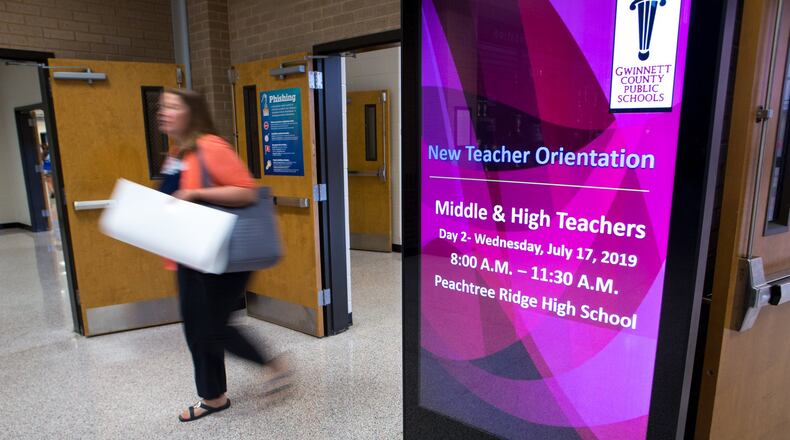It’s not often that school administrators hope for a string of zeros, but when Gwinnett County school board members read the quarterly teacher-vacancy report at the regular August meeting, all they saw were goose eggs.
A week into the new school year every educator position at the state’s largest school district was filled — even the hard-to-obtain special-needs teachers.
Dating back to the mid-2000s, teacher shortages are driven by a decline in college students choosing the profession, district efforts nationwide to return to pre-recession pupil-teacher ratios, increasing student enrollment and high teacher attrition.
More than 3,000 teachers left their jobs in metro Atlanta during the 2018-2019 school year, with many retiring, moving to other districts or leaving the profession. Just a month ago, Gwinnett still had more than 60 vacancies, while DeKalb County had around 280, Clayton County about 190, Atlanta Public Schools 25 and Cobb County 20.
» Related story: Gwinnett introduces new teachers to district’s culture
» Related story: Gwinnett schools makes list of best places to work for women
» Related story: Gwinnett teachers get small pay bump
“Can you share with us your secrets, your special sauce?” asked board member Everton Blair.
“There was no one thing that helped us fill all the teacher vacancies,” said Linda Anderson, associate superintendent for human resources and talent management. “And I certainly didn’t do it alone. I have a great team and worked diligently to attract teachers and ensure our schools are fully staffed.”
A study by Vanderbilt University showed that the local cost of teacher turnover can range from about $9,000 on average in a rural district to $21,000 on average in an urban district.
Analysis of high-performing urban schools by the Learning Policy Institute found these schools often have a prolonged hiring process that often includes meeting the principal, a teaching demonstration and debriefing and a school visit where the candidate meets other teachers.
Gwinnett utilizes many similar strategies, and recruiting began before school let out for the summer.
“We continued to hold job fairs at local schools during the hiring season and candidates had an opportunity to meet with other staff members and learn more about schools by being on site for the interview,” said Anderson.
During the summer months, the district held two walk-in job fairs every week, beginning June 26. For applicants who couldn’t make it in person, there were virtual job fairs as well.
“We had an opportunity to interview individuals from across the nation interested in relocating,” said Anderson.
One of those long-distance hires was Michael Stone, who moved from Utah. “Everyone has been so helpful as I transitioned my teaching license,” he said. Stone attended the new teacher orientation in July along with 1,300 first-timers to Gwinnett County Public Schools. “I arrived in Georgia on the 9th of July. I’m excited to be here,” said the new Graves Elementary teacher.
But talent close to home is just as crucial.
Laila Esmail didn’t have far to go.
“I live here. My kids go to school in Gwinnett County,” she said. “I think it’s the greatest school system in Georgia.”
She now teaches at Grayson High.
According to the Learning Policy Institute, effective teacher recruitment and retention includes:
- Policies and practices, including financial incentives, to make teaching careers more attractive and available to diverse candidates.
- Innovative programs that encourage and prepare young people and others to teach in their communities, which research indicates increases retention.
- Improved teaching and learning conditions, including access to academic resources and supportive services, skilled and supportive school leaders, and opportunities to collaborate and partner with peers and parents.
“We offer competitive salaries, top-notch benefit packages, ongoing support and staff development, and we work to recognize outstanding employees,” Anderson concluded. “(These) are just a few reasons why Gwinnett County Public Schools stand out.”
In a 2018 policy brief, the University Council for Educational Administration provided suggestions for state government officials and school district administrators to keep quality teachers.
Actions for State Policymakers
• Guarantee school districts are equitably and adequately funded
• Invest in developing a robust data system that allows for the calculation of teacher and principal turnover rates
• Make such data available to researchers so they can identify policies and strategies effective in reducing teacher turnover;
• Examine how the state identifies and supports “low performing” schools and ensure state approaches do not
cause disincentives for educators to work in such schools;
• Adopt the Professional Standards for Educational Leaders to ensure principal- and superintendent- preparation
programs adequately prepare education leaders;
• Fund both teacher and principal working condition surveys and make the results available to district and school leaders; and,
• Fund professional development
Actions for District Policymakers
• Ensure teacher salaries are competitive in the local labor market;
• Provide additional compensation and resources to educators choosing to work in high-need schools;
• Enact strategies targeted at placing and retaining experienced and effective principals at EVERY school;
• Provide all principals a mentor;
• Adopt and implement teacher working condition surveys and assist principals in addressing the challenge areas identified; and,
• Adopt and implement a principal working condition survey to help address principal turnover.
Source: University Council for Educational Administration
About the Author
Keep Reading
The Latest
Featured



